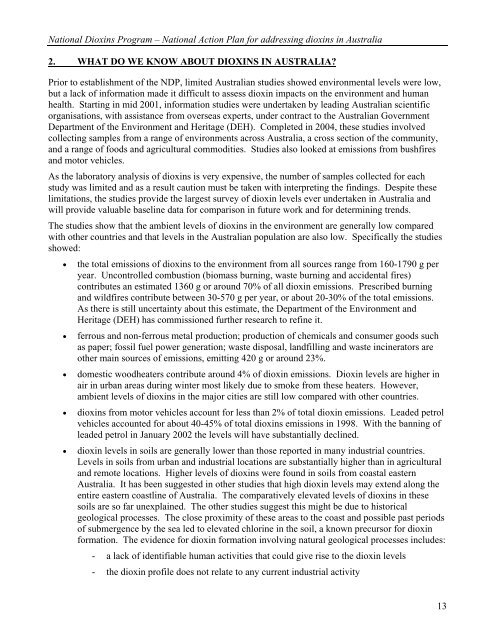National Action Plan for Addressing Dioxins in Australia
National Action Plan for Addressing Dioxins in Australia
National Action Plan for Addressing Dioxins in Australia
- No tags were found...
Create successful ePaper yourself
Turn your PDF publications into a flip-book with our unique Google optimized e-Paper software.
<strong>National</strong> <strong>Diox<strong>in</strong>s</strong> Program – <strong>National</strong> <strong>Action</strong> <strong>Plan</strong> <strong>for</strong> address<strong>in</strong>g diox<strong>in</strong>s <strong>in</strong> <strong>Australia</strong>2. WHAT DO WE KNOW ABOUT DIOXINS IN AUSTRALIA?Prior to establishment of the NDP, limited <strong>Australia</strong>n studies showed environmental levels were low,but a lack of <strong>in</strong><strong>for</strong>mation made it difficult to assess diox<strong>in</strong> impacts on the environment and humanhealth. Start<strong>in</strong>g <strong>in</strong> mid 2001, <strong>in</strong><strong>for</strong>mation studies were undertaken by lead<strong>in</strong>g <strong>Australia</strong>n scientificorganisations, with assistance from overseas experts, under contract to the <strong>Australia</strong>n GovernmentDepartment of the Environment and Heritage (DEH). Completed <strong>in</strong> 2004, these studies <strong>in</strong>volvedcollect<strong>in</strong>g samples from a range of environments across <strong>Australia</strong>, a cross section of the community,and a range of foods and agricultural commodities. Studies also looked at emissions from bushfiresand motor vehicles.As the laboratory analysis of diox<strong>in</strong>s is very expensive, the number of samples collected <strong>for</strong> eachstudy was limited and as a result caution must be taken with <strong>in</strong>terpret<strong>in</strong>g the f<strong>in</strong>d<strong>in</strong>gs. Despite theselimitations, the studies provide the largest survey of diox<strong>in</strong> levels ever undertaken <strong>in</strong> <strong>Australia</strong> andwill provide valuable basel<strong>in</strong>e data <strong>for</strong> comparison <strong>in</strong> future work and <strong>for</strong> determ<strong>in</strong><strong>in</strong>g trends.The studies show that the ambient levels of diox<strong>in</strong>s <strong>in</strong> the environment are generally low comparedwith other countries and that levels <strong>in</strong> the <strong>Australia</strong>n population are also low. Specifically the studiesshowed:• the total emissions of diox<strong>in</strong>s to the environment from all sources range from 160-1790 g peryear. Uncontrolled combustion (biomass burn<strong>in</strong>g, waste burn<strong>in</strong>g and accidental fires)contributes an estimated 1360 g or around 70% of all diox<strong>in</strong> emissions. Prescribed burn<strong>in</strong>gand wildfires contribute between 30-570 g per year, or about 20-30% of the total emissions.As there is still uncerta<strong>in</strong>ty about this estimate, the Department of the Environment andHeritage (DEH) has commissioned further research to ref<strong>in</strong>e it.• ferrous and non-ferrous metal production; production of chemicals and consumer goods suchas paper; fossil fuel power generation; waste disposal, landfill<strong>in</strong>g and waste <strong>in</strong>c<strong>in</strong>erators areother ma<strong>in</strong> sources of emissions, emitt<strong>in</strong>g 420 g or around 23%.• domestic woodheaters contribute around 4% of diox<strong>in</strong> emissions. Diox<strong>in</strong> levels are higher <strong>in</strong>air <strong>in</strong> urban areas dur<strong>in</strong>g w<strong>in</strong>ter most likely due to smoke from these heaters. However,ambient levels of diox<strong>in</strong>s <strong>in</strong> the major cities are still low compared with other countries.• diox<strong>in</strong>s from motor vehicles account <strong>for</strong> less than 2% of total diox<strong>in</strong> emissions. Leaded petrolvehicles accounted <strong>for</strong> about 40-45% of total diox<strong>in</strong>s emissions <strong>in</strong> 1998. With the bann<strong>in</strong>g ofleaded petrol <strong>in</strong> January 2002 the levels will have substantially decl<strong>in</strong>ed.• diox<strong>in</strong> levels <strong>in</strong> soils are generally lower than those reported <strong>in</strong> many <strong>in</strong>dustrial countries.Levels <strong>in</strong> soils from urban and <strong>in</strong>dustrial locations are substantially higher than <strong>in</strong> agriculturaland remote locations. Higher levels of diox<strong>in</strong>s were found <strong>in</strong> soils from coastal eastern<strong>Australia</strong>. It has been suggested <strong>in</strong> other studies that high diox<strong>in</strong> levels may extend along theentire eastern coastl<strong>in</strong>e of <strong>Australia</strong>. The comparatively elevated levels of diox<strong>in</strong>s <strong>in</strong> thesesoils are so far unexpla<strong>in</strong>ed. The other studies suggest this might be due to historicalgeological processes. The close proximity of these areas to the coast and possible past periodsof submergence by the sea led to elevated chlor<strong>in</strong>e <strong>in</strong> the soil, a known precursor <strong>for</strong> diox<strong>in</strong><strong>for</strong>mation. The evidence <strong>for</strong> diox<strong>in</strong> <strong>for</strong>mation <strong>in</strong>volv<strong>in</strong>g natural geological processes <strong>in</strong>cludes:- a lack of identifiable human activities that could give rise to the diox<strong>in</strong> levels- the diox<strong>in</strong> profile does not relate to any current <strong>in</strong>dustrial activity13
















